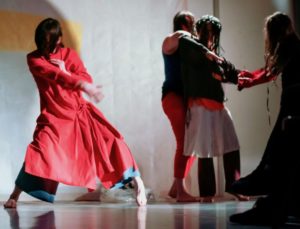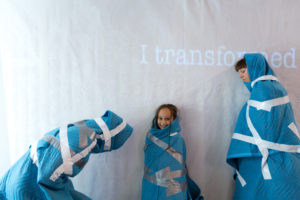 In trying times of transition, a resurgence of art and activism allows room for renewed questioning of assumed certainties. The current political climate has created a pressurized environment where artists have used their platforms to contest and reimagine the structures we are operating within, and many have been looking into the past to further inspire what our futures could be.
In trying times of transition, a resurgence of art and activism allows room for renewed questioning of assumed certainties. The current political climate has created a pressurized environment where artists have used their platforms to contest and reimagine the structures we are operating within, and many have been looking into the past to further inspire what our futures could be.
The spirit of revolutionary renewal has been a continual force throughout time and has served as unending inspiration for Erika Tsimbrovsky and her San Francisco-based group, Avy K Productions. Whether tackling an individual’s experience of creativity, such as Nijinsky’s journal in Nocturnal Butterflies (2009), or addressing artistic movements throughout time, such as in Un-Still Life (2015), the collective’s multimedia, improvised performances invest in the possibilities inherent in the creative present.
An artist of Jewish and Russian heritage who was educated under the Soviet Socialist Republic, Tsimbrovsky combatted an embedded discomfort with revolution through the practice of improvised performance, drawing inspiration from artists of the Russian Avant Garde movement whose work challenged her to reimagine the possible. In her work to connect the innovative spirit of the Avant Garde movement with today’s political and artistic climates, Tsimbrovsky articulates that “we are a product of the revolution, of its errors and consequences. The passion of the romantic spirit of the revolution and pain of its destruction are inside our bodies.”
Ruah Aduma/Red Wind has been in process for Tsimbrovsky since 2005; it has lived in various iterations of her performance practice but has most recently been explored at SAFEhouse Arts in San Francisco, May 2017 and at the Eleanor D. Wilson Museum at Hollins University in conjunction with her MFA thesis, June 2017. An hour-long installation/performance combining video, dance, poetry and live painting from Vadim Puyandaev, the work explores the undercurrent of the revolutionary spirit through time and specifically questions how the Russian Avant Garde movement can inform and contribute to artistic investigations today.
The Russian Avant Garde movement occurred between the 1890s and 1930s; Tsimbrovsky’s work focuses on themes of the movement that experienced a resurgence in America during the 1960s. Artists such as Kazimir Malevich, Wassily Kandinsky, Velimir Khlebnikov, and many others were ignited by witnessing political, societal and technological revolutions to imagine new futures through art. The artistic legacies of many of the artists were stunted when the Soviet government came into power, causing a violent silencing of dissenters. The movement, which embraced challenging authority and questioning of who has the power to shape identity, was not viewed favorably by the Soviet Union. After this period, art became commodified into propaganda and artistic possibilities that invested in exploration, such as abstraction, were deterred. The Avant Garde had utilized many mediums to question certainty, dismantling codified forms such as poetry and painting and abstracting them as a means of research.

Abstraction here becomes a means for envisioning possibility. In many ways the power to invest in abstraction was a spiritual awakening to otherness in the world and a resistance to given oppressive structures. During the resurgence of the Avant Garde movement in the United States, an investment in identity discourse and politics became a significant proponent of feminist possibility and queer empowerment. Developing discourse over both of these fields in the 1960s allowed for a further interrogation of the possibilities of abstract art. Queer and feminist forces were able to use abstract art as a means of perceiving and reflecting on radical change throughout their society.
Tsimbrovsky’s work engages dualisms that are not binary but contingent on each other for meaning; the horizon is created by the meeting of earth and sky, the movement of the work develops between form and force, we operate between understandings of the constructed and deconstructed, the meaning and meaninglessness, between Apollo and Dionysus. The balancing of opposing forces creates the zero point of happening. Between the certain(past) and uncertain(future) we experience the momentous present and all its innumerable possibilities, our own possibilities as individuals.
These dualistic ideas serve as the entry point to the structure of uah Aduma/Red Wind, connecting what Tsimbrovsky calls “flesh from the ancient past” and creating a new language to foresee a future ready for transformation. Abstraction when enacted through performance becomes a means of sharing an expansive exploration of the human subconscious beyond and within cultural borders. This shared experience, created through the collaboration of dancers, media and installation, hopes to reevaluate how the efforts of past artists inform our future.
“I believe we are experiencing another shift,” says Tsimbrovsky, “another time of change on all levels and in all systems.” During times of transition, when the future seems uncertain, the world can pulse with utopias full of potential. The culmination of these pasts, presents and futures within a performance seek to invest in the potential of the human spirit.
This article appeared in the April 2018 edition of In Dance.


